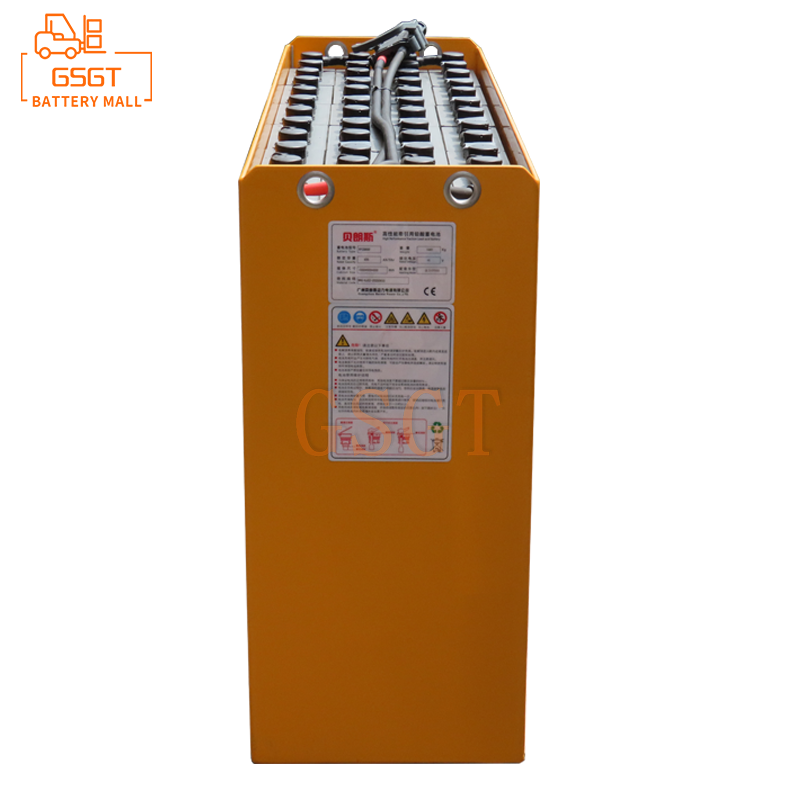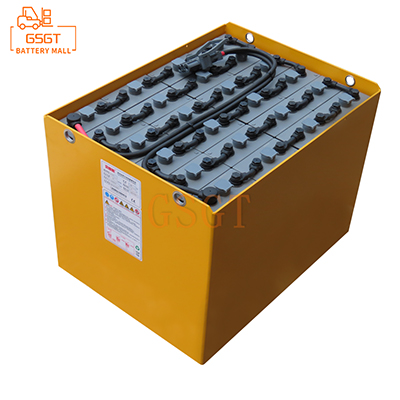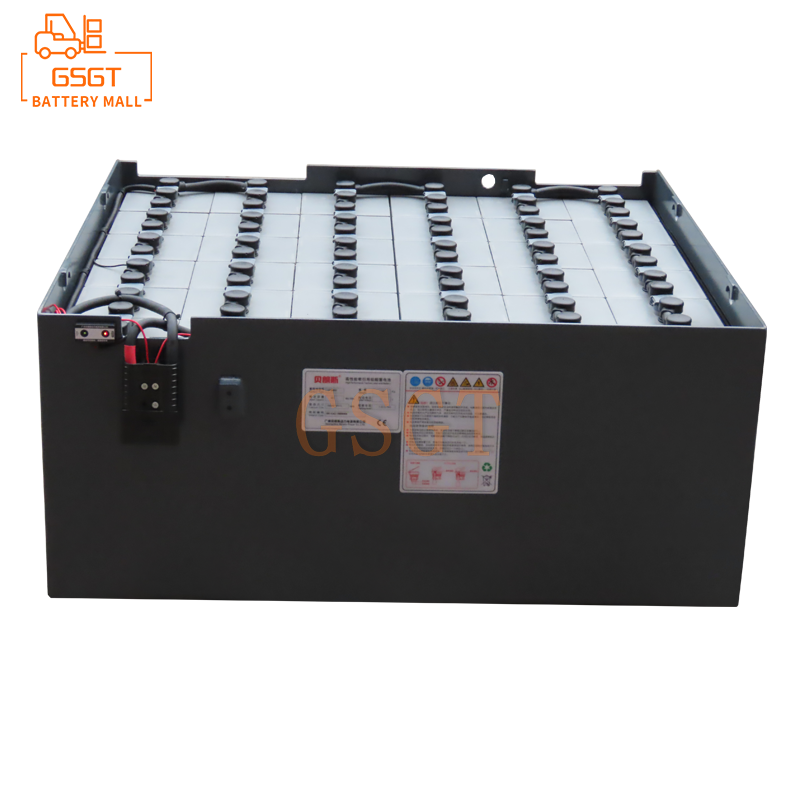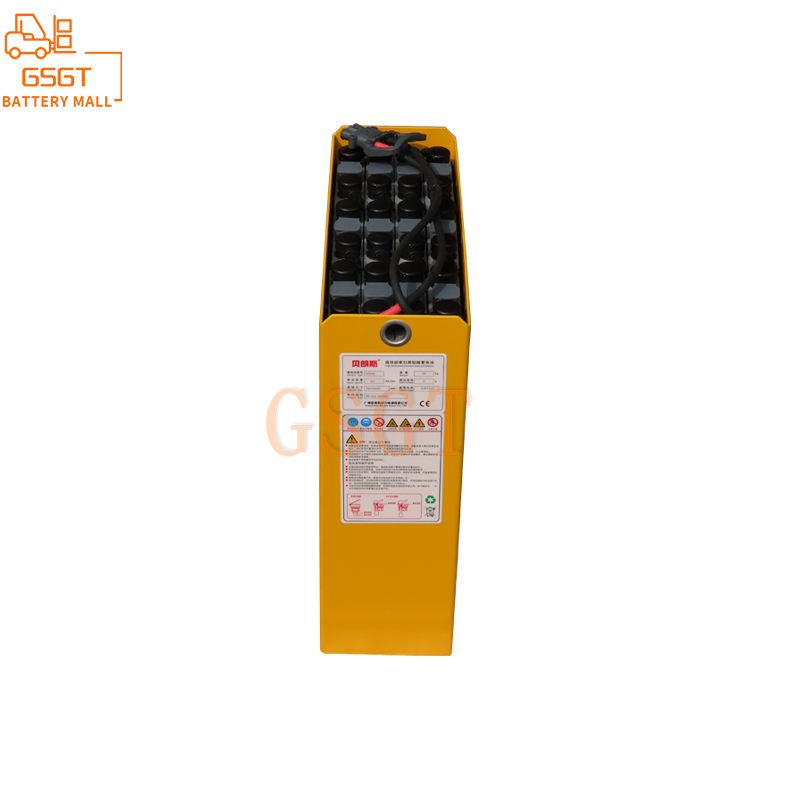Time:2025-04-19 13:29:11
Browse:626
In the modern logistics and warehousing field, forklifts, as important handling equipment, the choice of their power sources is of vital importance. Forklift lead-acid batteries, with their unique performance and advantages, occupy an important position in the forklift power system. This article will conduct an in-depth analysis of the performance and advantages of lead-acid batteries for forklifts, providing comprehensive and valuable references for related industries and users.
1. Basic Structure and Working Principle of ForkLift Lead-Acid Batteries
Forklift lead-acid batteries are mainly composed of positive and negative plates, separators, electrolyte, battery cases and other parts. The active substance on the positive plate is lead dioxide, and the active substance on the negative plate is spongy pure lead. The electrolyte is usually prepared by mixing sulfuric acid and distilled water in a certain proportion.
When the lead-acid battery of a forklift discharges, electrochemical reactions occur at the positive and negative electrodes of the battery. Lead dioxide at the positive electrode reacts with sulfuric acid and electrons to form lead sulfate and water. Pure lead at the negative electrode reacts with sulfuric acid, also generating lead sulfate and electrons. Electrons flow from the negative terminal to the positive terminal through the external circuit, thereby generating an electric current to provide power for equipment such as the motor of the forklift. During the charging process, an external power source inputs electrical energy to the battery, causing the above electrochemical reaction to proceed in reverse. Lead sulfate is reconverted into lead dioxide and pure lead, and at the same time, the concentration of sulfuric acid in the electrolyte is restored, allowing the battery to store electrical energy again.
2. Performance Characteristics of Lead-Acid Batteries for Forklifts
(1) Stable voltage output
During the discharge process of forklift lead-acid batteries, they can provide a relatively stable voltage. Throughout the entire discharge cycle, the voltage fluctuation range is relatively small, which makes the power output of the forklift relatively stable.
(2) Good low-temperature performance
Although the performance of lead-acid batteries may decline in low-temperature environments, compared with some other types of batteries, forklift lead-acid batteries still have a certain degree of low-temperature adaptability. By adopting special plate materials and electrolyte formulas, forklift lead-acid batteries can to a certain extent reduce the impact of low temperatures on their performance. In a low-temperature environment of around -20℃, forklift lead-acid batteries can still maintain a certain discharge capacity. Although their capacity may decrease, they can still meet the short-term operation requirements of forklifts in some low-temperature conditions. At the same time, by insulating the battery, such as installing insulation covers and other measures, its performance in low-temperature environments can be further improved.
(3) High energy density and long battery life
Forklift lead-acid batteries have a relatively high energy density and can store a large amount of electrical energy within a unit volume or unit mass. This enables the forklift to operate continuously for a relatively long time after being fully charged. Take the common 48V, 800Ah lead-acid battery for forklifts as an example. Under normal warehouse operation conditions, forklifts can work continuously for 6 to 8 hours, meeting the daily work requirements of most forklifts. Moreover, with the continuous advancement of technology, the energy density of forklift lead-acid batteries is gradually increasing, and it is expected to achieve longer driving range in the future.
(4) Reliable cycle life
Forklift lead-acid batteries have a certain cycle charge and discharge life. Generally speaking, high-quality lead-acid batteries for forklifts can be charged and discharged about 1,500 times under normal usage and maintenance conditions. This means that during the service life of the forklift, lead-acid batteries do not need to be replaced frequently, reducing the usage cost and maintenance workload. Moreover, through reasonable charging control and usage methods, its cycle life can be further extended, and the battery's utilization efficiency and economy can be improved.
3. Advantages of Lead-Acid Batteries for ForkLifts
(1) Significant cost advantage
Compared with other types of forklift power sources, such as lithium batteries, the initial purchase cost of forklift lead-acid batteries is relatively low. The production technology of lead-acid batteries is mature, the raw materials are widely available, and the production process is relatively simple, which enables effective control of their production costs. For some small and medium-sized logistics enterprises and warehousing sites, purchasing forklifts equipped with lead-acid batteries can not only meet the basic operation requirements but also reduce the equipment procurement costs. In addition, the maintenance cost of lead-acid batteries for forklifts is also relatively low. Its maintenance process mainly includes simple operations such as regularly checking the electrolyte level, adding distilled water, and cleaning the battery surface. It does not require complex professional equipment or techniques. Generally, forklift operators can complete it after simple training, which greatly reduces maintenance costs and difficulty.
(2) Relatively high security
The safety of lead-acid batteries for forklifts has performed well in practical applications. The electrochemical reaction inside it is relatively mild and does not have serious safety hazards such as thermal runaway and explosion like lithium batteries. The electrolyte of lead-acid batteries is a sulfuric acid aqueous solution. Even if leakage occurs, it will not be as highly corrosive and toxic as the electrolyte of lithium batteries. During the daily use of forklifts, even in the event of unexpected situations such as collisions and compressions, lead-acid batteries are not prone to severe chemical reactions or safety accidents. Meanwhile, the structural design of lead-acid batteries ensures that their internal pressure is relatively stable, preventing dangerous situations such as explosions due to excessive internal pressure. This provides a reliable guarantee for the safe operation of forklifts.
(3) The technology is mature and the supporting facilities are complete
After years of development, the technology of forklift lead-acid batteries has become very mature. Whether it is the production and manufacturing process or the performance optimization and improvement of batteries, there has been a great deal of research and practical experience. This makes the quality of forklift lead-acid batteries stable and reliable, and their performance consistent. Meanwhile, the supporting facilities for lead-acid batteries are also very complete. In the market, there are numerous manufacturers and suppliers of lead-acid batteries, capable of providing battery products of various specifications and models to meet the needs of different types of forklifts. In addition, the maintenance and after-sales service network for lead-acid batteries is also relatively complete. Once a battery malfunctions, it can be repaired and replaced in a timely manner to ensure the normal operation of forklifts. Moreover, the recycling and processing technology for lead-acid batteries has also matured, enabling effective resource recovery and reuse, and reducing environmental pollution.
(4) Wide applicability
Forklift lead-acid batteries are suitable for various types and specifications of forklifts. Whether it is a small manual hydraulic forklift or a large electric counterbalanced forklift, lead-acid batteries can be used as the power source. Moreover, according to the working requirements and working environments of different forklifts, lead-acid batteries of different capacities and voltages can also be selected for configuration. For instance, in indoor warehousing operations, for forklifts with lower work intensity and shorter operation time, lead-acid batteries with relatively smaller capacity can be selected. For forklifts used in places with high work intensity and long working hours, such as logistics parks, large-capacity lead-acid batteries can be configured to meet their requirements for continuous operation for long periods.
4. Application Scenarios and Future Development Trends of Lead-Acid Batteries for Forklifts
(1) Main Application Scenarios
1. ** Warehousing and logistics field ** : In places such as warehouses and logistics centers, forklifts need to frequently perform operations such as transporting and stacking goods. Forklift lead-acid batteries, with their stable performance and long endurance, can meet the working requirements of forklifts in these places and ensure the efficient flow of goods.
2. ** Manufacturing ** : In factory workshops, forklifts are used to transport raw materials, semi-finished products and finished products. The safety and cost advantages of lead-acid batteries make them a common choice for forklift power in manufacturing, providing a guarantee for the smooth progress of the production process.
3. ** Ports and Terminals ** : At ports and terminals, forklifts need to operate under various complex environmental conditions, including humidity and high temperatures. The excellent adaptability and reliability of forklift lead-acid batteries enable them to operate normally in these harsh environments and assist in tasks such as loading, unloading and handling containers.
(2) Future Development Trends
1. ** Technological Improvement and Performance Enhancement ** : In the future, forklift lead-acid batteries will continuously undergo technological improvements to further enhance their performance. For instance, by optimizing the material and structure of the plates, the charging and discharging efficiency and energy density of the battery can be enhanced; Improve the electrolyte formula to enhance the low-temperature performance and cycle life of the battery.
2. ** Intelligence and Informatization ** : With the development of the Internet of Things and intelligent technologies, forklift lead-acid batteries will achieve intelligent management. By installing sensors and smart chips on the battery, parameters such as voltage, current, temperature and remaining power of the battery can be monitored in real time, and the data can be transmitted to the management system. Managers can keep track of the battery status at any time through terminal devices such as mobile phones or computers, make reasonable charging arrangements and maintenance management, and improve the battery's utilization efficiency and lifespan.
3. ** Integration with New Energy Technologies ** : Although lead-acid batteries have many advantages, under the general trend of new energy development, they will also be integrated with other new energy technologies. For instance, when combined with renewable energy sources such as solar and wind power, it can achieve green charging, reduce reliance on traditional power grids, and at the same time lower carbon emissions, meeting environmental protection requirements.
In conclusion, forklift lead-acid batteries play a significant role in the field of forklift power due to their stable performance, notable cost advantages, high safety, and wide applicability. Despite facing competition from other new battery technologies, through continuous technological innovation and development, forklift lead-acid batteries will still have broad application prospects and development space in the future, providing reliable power support for the development of modern logistics and industrial production.

$3810

$3405

$4045

$1270

MESSAGE
Professional And Efficient
Security
Affordable Price
Professional Services